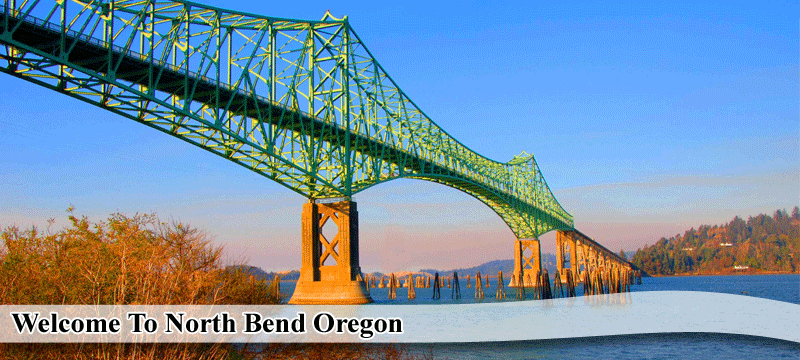Situated on a “north bend” of
the Coos Bay estuary, the
town’s history dates back to the 1850s, when there were
sawmills and a
handful of houses. It took the vision of an early 20th Century
lumberman
named Louis Simpson to make the settlement into a proper city, with the
proper name North Bend. Simpson’s father had started the
town’s original
sawmill, and the businesses expanded to include mills that turned out a
variety of wood products, from fruit boxes to fancy doors. There were
machines
shops and foundry, a woolen mill, a furniture factory, milk condesary,
brewery and two shipyards, which turned out a steady stream of wooden
schooners
that took Simpson lumber to San Francisco and other distant markets.
North
Bend had the region’s first hospital, three churches and
probably three
times as many saloons and brothels.
North Bend claims a place in aviation history. In
1913,
Vern Gorst brought a hydroplane to North Bend. In 1925 Pacific Air
Lines,
and air mail carrier with an occasional passenger riding uncomfortably
atop the mail sacks, was founded by Gorst in the North Bend Hotel.
Pacific
Air Lines later merged with other companies to become United Airlines.
During World War II, Kruse and Banks Shipyards
built minesweepers
and rescue tugs for the United States Navy. In 1960, Pony Village
Shopping
Center, the first covered mall on the Oregon Coast, was established.
Industrial
activity of the 1950s through 1970s centered on forest products, but
the
town’s main sawmills closed in the 1980s as timber companies
finished cutting
the region’s old-growth forests.
Recreational activities increased, tourism grew,
and service
industries added workers, including many at the Mill Casino and Hotel,
built on the site of a former sawmill. The future will be different
from
the past, but North Benders remain proud of their schools, their town,
and their people.
The town is situated along US 101 about 5 miles north of
Coos
Bay. There are full services, including motels, supermarkets and Pony
Village
Mall, largest indoor mall on the Oregon Coast. No RV parks at present,
but there are many in the adjacent city of Coos Bay, as well as public
campgrounds just north in the Oregon Dunes National
Recreation Area.
The downtown, consisting of many fireproof masonry
buildings
dating to the early years of the 20th Century, are slowly being
restored,
and still house a number of lively businesses, including antique and
collectibles
shops and used book stores.
The town’s main event is the July
Jubilee, which celebrates
the frontier spirit.
North Bend's early town life was
raw - a coastal frontier,
full of saloons and bawdy houses for workingmen and lumberjacks.
Virtually
every downtown building had rooms for drinking, gambling, or
prostitution.
Other town elements, however, battled for respectability, organizing
church
groups and civic associations.
Many of North Bend's existing structures were
constructed during the
1920's and were made of concrete, rather than fire-prone wood. This era
was highlighted by a commercial boom, civic progress, and some
bootlegging.
North Bend claims a place in aviation history. In
1913,
Vern Gorst brought
a hydroplane to North Bend. In 1925 Pacific Air Lines, and air mail
carrier
with an occasional passenger riding uncomfortably atop the mail sacks,
was founded by Gorst in the North Bend Hotel.
During World War II, Kruse and Banks Shipyards
built
minesweepers and
rescue tugs for the United States Navy. In 1960, Pony Village Shopping
Center, the first covered mall on the Oregon Coast, was established.
Industrial
activity of the 1950's through 1970's centered on forest products as
national
corporation continued sawmill and pulp mill operations.
Recreational activities increased, tourism grew,
and
service industries
added workers in the 1980's. The future will be different from the
past,
but North Benders remain proud of their schools, their town, and their
people.







